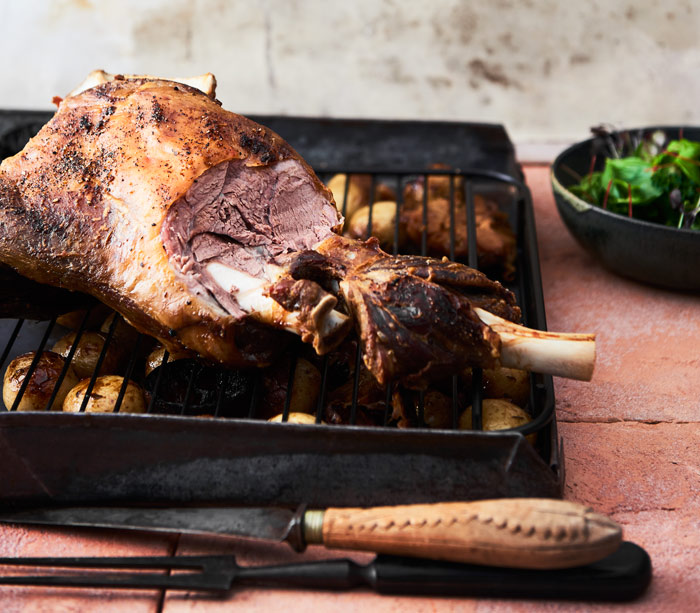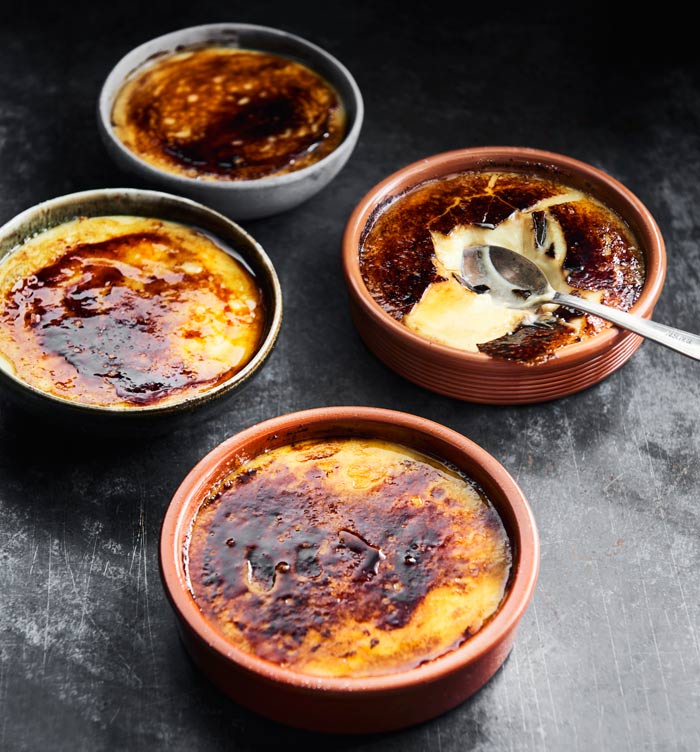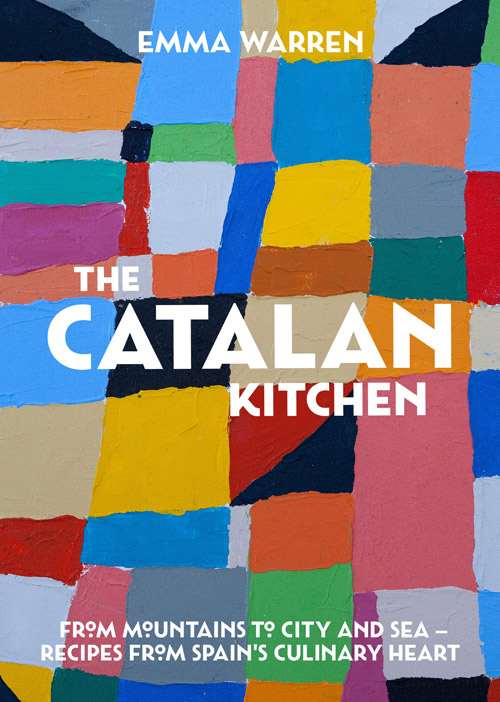From mountains to city and sea, The Catalan Kitchen is a celebration of 100 authentic and traditional dishes from Spain’s culinary heart.
Catalonia came to global attention recently in its quest for independence, but there is much more to this beautiful region situated on the west coast of the Mediterranean and blessed with one of the richest food cultures in Europe.
The Catalan Kitchen brings together seasonal produce, innovative cooking and passionate dedication towards food to celebrate a unique cuisine that’s intrinsically bound to history, creativity and identity.
Catalan dishes are heavily influenced by pork and fresh seafood with a focus on fresh, seasonal produce. Recipes can be as simple as crushed tomatoes smeared on bread to hearty, slow-cooked stews. Famous dishes include calcots – large salad onions cooked on a coal barbecue and dipped into nutty and addictive Romesco sauce, a unique paella made without saffron and the addition of vermicelli noodles, myriad types of Catalan sausage served with white beans, sauces such as aioli and picada, and multiple pastries and desserts including the crema Catalana (a version of crème brûlée).
Author Emma Warren has been sous chef to some of Australia’s biggest names including Karen Martini. When she’s not working in some of Melbourne’s most famous restaurants, she can be seen working as home economist extraordinaire to some of Australia’s best-loved celebrity chefs including Matt Preston. Emma earned her chef wings in Barcelona and is classically trained in Catalan cuisine. The Catalan Kitchen is her first book.
Below you will find three recipes courtesy of Simon & Schuster Australia: Baby Broad Bean & Pea Salad, Oven-roasted Lamb Shoulder and a Crema Catalana dessert. If you can’t wait for our review to find out what other great recipes are inside, the book is available in shops now!
BABY BROAD BEAN & PEA SALAD (AMANIDA DE FAVETES I PÈSOLS)
SERVES 4
- 500 ml (17 fl oz/2 cups) vegetable stock
- ½ bunch tarragon
- 200 g (7 oz) fresh or frozen podded broad (fava) beans
- 150 g (5½ oz) fresh or frozen podded peas
- 2 mint sprigs, leaves thinly sliced
- sea salt and freshly cracked black pepper
- 3 tablespoons extra virgin olive oil
- 1 tablespoon sherry vinegar
- 1 teaspoon freshly grated ginger
- juice of ½ lemon
- ¼ radicchio, shredded
- 100 g (3½ oz) queso fresco or firm ricotta
Bring the vegetable stock and two tarragon sprigs to the boil in a medium saucepan over medium–high heat.
Blanch the broad beans for 2 minutes then, using a slotted spoon, remove from the stock and immediately transfer to a bowl of iced water. Remove the outer skins of most of the larger beans, leaving the smaller ones intact for a touch of bitterness.
Bring the stock back to the boil and blanch the peas for 4 minutes, then strain and cool in the iced water.
Finely chop the remaining tarragon leaves and place in a medium bowl with the blanched broad beans and peas, mint, a pinch of salt and pepper and half the olive oil.
In a separate bowl, combine the vinegar, ginger, lemon juice and remaining oil, then toss through the shredded radicchio. Mix this through the broad bean and pea mixture.
Transfer the salad to a serving platter and dot the queso fresco or ricotta over the top.
Authors note:
Catalans love, love, love their broad (fava) beans! So hardy and easy to grow, they set up the vegetable garden for the rest of the summer’s plantings by fixing much-needed nitrogen in that deliciously rich Catalan soil.
Inspiration for the flavour combinations in this dish comes from one of my favourite restaurants, Can Fabes – owned by three-Michelin star chef Santi Santamaria, who has since sadly passed away – located in the beautiful broad bean-growing lands of Sant Celoni, situated between the Montseny and Montnegre massifs. My favourite meal was an aspic-like jelly packed full of teeny-tiny, bright green podded baby broad beans with the mild, fresh essence of ginger. So clean and unforgettable.
If you can find it in a deli, finely shaved duck jamón, tossed through at the end, dresses up this salad beautifully.
OVEN-ROASTED LAMB SHOULDER (ESPATLLA DE XAI AL FORN)
Serves 4
- 500 g (1 lb 2 oz) rock salt
- 2 sprigs rosemary
- 2 fresh bay leaves
- 1 cinnamon stick, halved
- 8 juniper berries
- 2–2.5 kg (4 lb 6 oz–5½ lb) lamb shoulder, bone in
- 1 tablespoon extra virgin olive oil
- 1 teaspoon freshly cracked black pepper
- 125 ml (4 fl oz/½ cup) sherry vinegar
- 125 ml (4 fl oz/½ cup) dry white wine
- 2 garlic bulbs, cut in half crossways
- 2 lemons, halved
- 500 g (1 lb 2 oz) chat (baby) potatoes
- 1 teaspoon salt flakes
- mixed fresh herbs, such as mint, dill, parsley, basil and tarragon leaves, to serve
In a blender, blitz the salt, one rosemary sprig, one bay leaf, half the cinnamon and the juniper berries until evenly chopped.
Place the lamb in a large baking dish and rub with the salt mix to coat. Set aside in the fridge for 2 hours.
Preheat the oven to 230°C (445°F) fan-forced.
Rub the salt off the lamb and rinse well. Pat dry with paper towel and allow to air-dry on a wire rack at room temperature for 30 minutes.
Smear the lamb with the olive oil and sprinkle with the pepper. Place the lamb and the wire rack on top of a baking dish and pour the vinegar, wine and 1 litre (34 fl oz/4 cups) water into the base of the dish. Throw in the garlic, two lemon halves and the remaining rosemary, bay leaf and cinnamon. Roast for 30 minutes, then remove from the oven and turn the shoulder over. Reduce the temperature to 150°C (300°F) and return the lamb to the oven and roast for a further 30 minutes. Remove, turn the lamb over again and place the potatoes in the baking dish. Return to the oven for another 30 minutes. Keep an eye on the liquid and add a little more water if the baking dish is dry and the potatoes are starting to burn. Finally, increase the heat back to 230°C (445°F), turn the lamb shoulder one last time and roast for 15 minutes.
Transfer the lamb and potatoes to a large serving dish. Squeeze the remaining lemon halves over the potatoes and sprinkle with the salt.
Scatter the herbs over the lamb and serve.
Authors note:
Catalan families often eat this dish a couple of times during the Christmas period, kicking off on 8 December and carrying on through to Three Kings’ Day on 6 January. It’s sometimes served as a late night dinner on the ‘Nit de Nadal’ (good night) or Christmas Eve.
CATALAN CRÈME BRÛLÉE (CREMA CATALANA)
- 1 litre (34 fl oz/4 cups) full-cream (whole) milk
- 1 cinnamon stick
- peel of ½ lemon
- peel of ½ orange
- 7 large egg yolks
- 200 g (7 oz) caster (superfine) sugar
- 3 tablespoons cornflour (cornstarch)
Gently warm the milk, cinnamon and citrus peels in a medium saucepan over medium–low heat until just until simmering. Remove from the heat and allow to stand for 15 minutes for the flavours to infuse.
Whisk the egg yolks in a large heatproof bowl, then whisk in 150 g (5½ oz) of the sugar until creamy. Whisk in the cornflour until well combined.
Strain the warmed milk into a jug, then slowly pour into the egg mixture, whisking to combine.
Pour the custard back into a clean saucepan and return to medium– low heat, stirring continuously with a wooden spoon or silicon spatula. Allow to gently simmer and bubble, moving the custard constantly to avoid scrambling on the bottom.
When thick and coating the back of the spoon, remove from the heat and strain through a fine sieve. This will pick up any scrambled egg from the base of the saucepan.
Evenly divide the custard among 4–6 ramekins, leaving a 5 mm (¼ in) gap at the top of each ramekin. Transfer to a tray and allow to cool slightly before refrigerating for at least 4 hours or ideally overnight.
To serve, sprinkle the remaining sugar over the top of the custards and caramelise to a hard crust using a blow torch or sugar iron.
You can also caramelise the set custards under the grill (broiler). Place the custards in a baking dish half filled with iced water, sprinkle the sugar over the ramekins and grill (broil) until well caramelised.
Authors note:
The French compete with Catalunya for the origin of this famous dish; however, there are some small differences. Quicker, easier and cheaper, the Catalans cook out the egg a little further on the stovetop and set their custards in the fridge with the help of cornflour (cornstarch), as historically many people didn’t have access to ovens. They also use milk, not cream – another peasant compromise.
From The Catalan Kitchen: From Mountains to City and Sea – Recipes from Spain’s Culinary Heart by Emma Warren. Photography © Rochelle Eagle | Food styling © Lee Blaylock (Smith Street Books, October 2018 – AU$ 55, NZ$ 65)


























